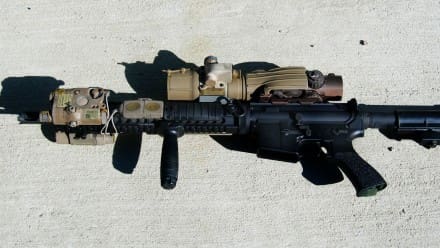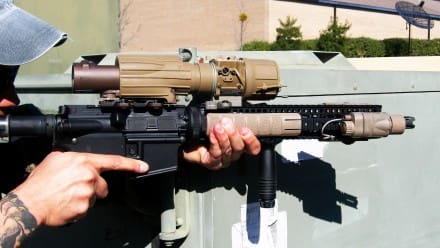Evolving at the Speed of War
In 2007, during the height of the war against extremists in Iraq, I was a sniper with the Commander In-Extremis Force (CIF)[a] operating out of Baghdad. We conducted unilateral operations against HVTs, targeting these as part of a larger task force known as TF-16. While conducting these operations we began identifying inefficiencies in the way we executed our roles as snipers.
An immediate issue was the multitude of different weapon systems and equipment necessary to carry out our main duty during different phases of missions – as snipers, we were tasked with containing the objective prior to a raid, which meant seeking high ground and containing from the top down providing coverage for the assault force. We used .300 Win mag MK13 sniper rifles, which were cumbersome but effective against enemy personnel. However, it was impossible to assault with these weapons, meaning we had to bag them in rifle packs and use carbines to make our way to high ground – complete with accessories and combat loads of ammunition.
Our carbines utilized SOPMOD accessories – but on a 16-inch long M4 with a 6-inch picatinny rail, fitting a light, optics, BUI sights, lasers, and pressure pads as well as a universal night sight proved difficult. We had to work out how to overcome this issue, and work out a way to optimize and evolve our equipment to allow us to conduct an offset, assault a target and provide adequate coverage in and around a 300-meter area, even at night.
We began work on optimizing a Designated Marksman Rifle (DMR), chambered in 5.56mm, that not only met but far exceeded these requirements. We purchased and mounted free-floating 15-inch rails, and had the JSOC armor optimized to in order to keep a 75g Hornady round as flat as possible. In testing at Accuracy First in Canadian, Texas, we found the rifle successful at a thousand meters, after deciding on an optic setup that brought the whole package together.
After extensive testing we had a rifle that gave us a platform allowing us not only to assault, but to effectively engage targets at a distance, at night. This was put to the test on a rooftop in Sadr City in 2007 when my senior and I, a legend in the sniper community named ‘Irish,’ took a shot from a couple of hundred meters out on a maneuvering insurgent after clearing the house. I looked at him, he looked at me and we shook our heads in mutual agreement. Our hard work had paid off.
– Mike Glover
FieldCraft LLC
A former Special Forces disabled veteran with more than 18 years of military service, Mike has operated at the highest levels of Special Forces. Deploying 15 times to combat theaters, he has served in the following positions: SF Weapons Specialist, SF Sniper, SF Assaulter/Operator, SF Recon Specialist, SF Joint Terminal Air Controller (JTAC), SF Team Sgt, and SF Operations SGM.
Mike is a certified U.S. Government federal firearms instructor, and has also has trained mobility with Team O’Neil Rally School, BSR Racing, and BW drivers courses. He is medically trained every two years in Advanced Medical Trauma and continually maintains his re-certifications for consultation practices.
Considered a Subject Matter Expert (SME) in planning and executing Special Operations in a myriad of complex environments, Mike has taken his 18 years of experience and is giving the American citizen the applicable training tools and training necessary to better protect themselves and their families here and abroad.
Mike has a Bachelors degree in Crisis management and homeland security with American Military University and is pursuing his masters in military history.
Mike currently lives in northern California, where he continues to consult for the U.S. Government in security and firearms instruction.
Gunfighter Moment is a weekly feature brought to you by Bravo Company USA. Bravo Company is home of the Gunfighters, and each week they bring us a different trainer to offer some words of wisdom.
Tags: BCM, Bravo Company, Fieldcraft LLC, Gunfighter Moment, Mike Glover





Great article! Can we get a parts list on the rifle, equipment and ammo that was used? Thank you.
Looks like a LaRue, longer than what is currently commercially available. Possibly the whole upper. LaRue did confirm sales of uppers to 5th SFG.
You mean the ones that keyholed?
I glossed over the part where he described swapping a new upper onto a 16″ carbine barreled M4, so that eliminates the idea of full LaRue upper. But to answer your question: I know nothing, I’m just trying to understand the pretty pictures.
For example, is that really a DPMS tactical bolt catch?
I would be really curious to know what barrel was actually used. To my (very limited) knowledge the only other 16″ carbine barrels issued were the original Recce Liljas then the Mod H Noveskes. I would also like to know why Hornady 75 BTHP came down the pipe, just a more lethal projectile than 77 SMK? Lots of interesting questions raised by this post. Any information would be appreciated.
Erg, that should read “swapping a new handguard” not “swapping a new upper.”
The rails as I remember were Daniel Defense and then I believe we migrated to Troy.
Some of the parts we used:
-SOPMOD accessories
-ELCAN
-Ergo Grips
-The small red wedges for uppers and lowers
-Geiselle (two stage triggers)
-SOCOM 1/7 barrels (hand picked)
-Surefire Brakes
-75 GR Hornady
All this was obviously years ago (BCM) my carbine of choice now has been doing it right since the beginning.
The issue in SOF was the restrictions that most units were held too by Crane-not that they were bad-just they didn’t at the time augment the needed equipment for specific special missions. For example the 10inch barrel wasn’t available-so we procured them. Later crane released it to the force years later-and they were forced to turn in 14.5s. With trips to rural Afghanistan that obviously was an issue especially with 55/62gr.
Huh, that sure looks like a LaRue in the picture though. You can see the knurling around the handguard nut and some white lettering where the Texas logo would be. Maybe you’re thinking of other carbines you built up at the time?
“Accu-wedges” is the word you’re looking for I think.
When you say you procured barrels, especially the 16″ barrels mentioned in the original post, do you recall if Colt was the vendor on them? M4A1 profile, M203 cuts, stuff like that? I’m curious as Lilja and Noveske are the only two 16″ barrel vendors I think were known about until now. Thanks for indulging the interwebs’ curiosity on this.
Nice site by the way. I’m digging the first aid and survival kits. Mine need to shed some fat and I’ve been looking at some off the shelf offerings because the pouches are sized right for the contents.
Thanks for your responses!
Just saw your reply below about the LaRue, disregard first graf.
You got any more info on the keyholing problem?
Ask most anybody who was in the CIF when they bought the uppers. A few guys won’t be too pleased to talk about it, but there are plenty of guys who will.
You are correct, this modified platform has a Larue Rail.
Good adaptation of weapon systems for highly mobile night operations. Elcan DR 1-4x and a CNVD PVS-24. A deadly combination for the precision engagements at the distances described.
Thanks for the info. BTW, your website is awesome.
Thanks guys for the support!!!
Thanks for the input. On the rail-daniel defense and troy rails were used at different time periods, and 75 gr hornady was used in conjunction with a 1/7 chrome lined barrel. The SOCOM barrels are decent we just wanted to overall “optimize” the platform. Thanks again for the feedback.
Gotta love how “I’m sick of carrying all this crap” kinda becomes the mother of many great inventions in the military.
I blew past this sentence in the article, then went back to savor it:
“In testing at Accuracy First in Canadian, Texas, we found the rifle successful at a thousand meters,”
1000 meters.
Most excellent.
Courtesy of Todd Hodnet-man is the god father of the modern Sniper and a great friend and mentor.
“…and had the JSOC armor optimized to in order to keep a 75g Hornady round as flat as possible.”
May I ask for an explanation?
What does the armor have to do with the bullet trajectory?
Probably meant armorer.
sounds a little false for me, armorers have nothing to do with bullets unless he installed a 1:7 twist barrel…..
What? You don’t think JSOC armorers don’t have specialized spare parts and the authority to do mods without sending them to depot?
JSOC armorers are some of the most talented gunsmiths in the world bruh.
1/7 is standard, when he said optimize I thought more like 1/8 for a 75gr
Armorers in Special Operations do not just fix and repair, they absolutely are involved in any modification project and closely inspect all weapon systems for compliance. In this case the armorer did utilize the 1/7 socom barrel (Standard issue) but also worked with us on the rail, accessories to make sure we were within the regulations on the project. The biggest issue was honestly the rail space, on the 6 inch it just wasn’t enough. Another example was the use of the 10inch shorty, when we were doing raids we didn’t have this option for a bit, especially SF as a whole, once “CRANE” caught up, they were swapping units 14.5s for 10’s, with subsequent deployments to Astan-obviously an issue for reaching out with 55.62gr. Thanks for your feedback.
Mike
Thanks guys for the feedback-would love to answer some of your questions. Kryptek man-b_a-absolutely right a 1/7 was added to optimize the 75 gr. Also-special operations Armorers don’t just work in the function of weapons repair but they’re also the authority on what can be modified on weapons period-so in this case if it wasn’t approved or modified by approved Armorers then it couldn’t be done. I used optimize to describe the overall modifications that improved overall accuracy which included barrel/rail/buffer/optics-etc.
Why the 75gr Hornady vs the Mk262 77 SMK stuff? Mk262 just not fielded widely enough yet or did you prefer the 75 over the 77 for other reasons?
Thanks again for your replies and sorry for the redundant questions.
Thanks for taking the time to write this up and answer all these questions. The development of rifles like the Mk12, the “Recce”, and all the various home brew carbine uppers and stuff has been a passion of mine for a number of years now. A lot of what you mentioned falls squarely in line with a chat I had with Jim Gilliland during his class the other week, discussing the M4 and using it to great effect in urban areas and just making things work to fit the need. In that same class I found my 18″ and 16″ to do quite well out to 800, using a Mk262 knockoff for ammo.
While one particular Navy “Recce” pattern gets a lot of attention, it’s cool to me to see how so many other units were basically doing the same thing and approaching it differently for so many years before.
My question is, do you feel like the current Block II iteration of upgrades to the M4A1, with the DD rail and SOCOM barrel, suppressors, and some of the available optics like Nightforce, all combined with the Mk262 round, are filling that need you guys were trying to fill years ago?